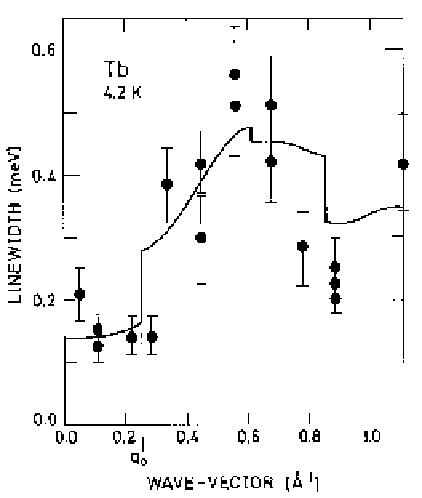Environmental Engineering Reference
In-Depth Information
Fig. 5.13.
The linewidths of magnons propagating in the
c
-direction of
Tb at 4 K, compared with a theory based upon the nearly-free-electron
model. The abrupt changes in the calculated lifetimes are due to the
spin-splitting of the Fermi surface.
The lifetimes of the magnons propagating in the
c
-direction in Tb
at 4 K, at which temperature the conduction electrons provide the dom-
inant scattering process, were measured by Bjerrum Møller and Mack-
intosh (1979). As illustrated in Fig. 5.13, the linewidths are small, but
non-zero, at small wave-vectors, rise abruptly at about a quarter of the
way to the zone boundary, and fall again at large
q
. In order to inter-
pret these results rigorously, it would be necessary to use eqn (5.7.27),
with the correct band structure for Tb and realistic values for the ex-
change matrix elements
I
(
n
k
,n
k
). However, it is possible to obtain a
semi-quantitative description by using the simple free-electron expres-
sion (5.7.37). As we shall see in the remainder of this section, this model,
with an
sf
-interaction determined, for example, from the polarization of
the conduction electrons (5.7.16-19), gives a surprisingly good account
of the real scattering processes involving the interaction between the 4
f
and conduction electrons. Although the dominant
d
bands are far from
parabolic in the rare earths, the nearly-free-electron Fermi surface for a
trivalent hcp metal has a sheet with the form of a lens normal to the
c
-axis (Mackintosh
et al.
1963), which mimics the Fermi-surface webbing

Search WWH ::

Custom Search